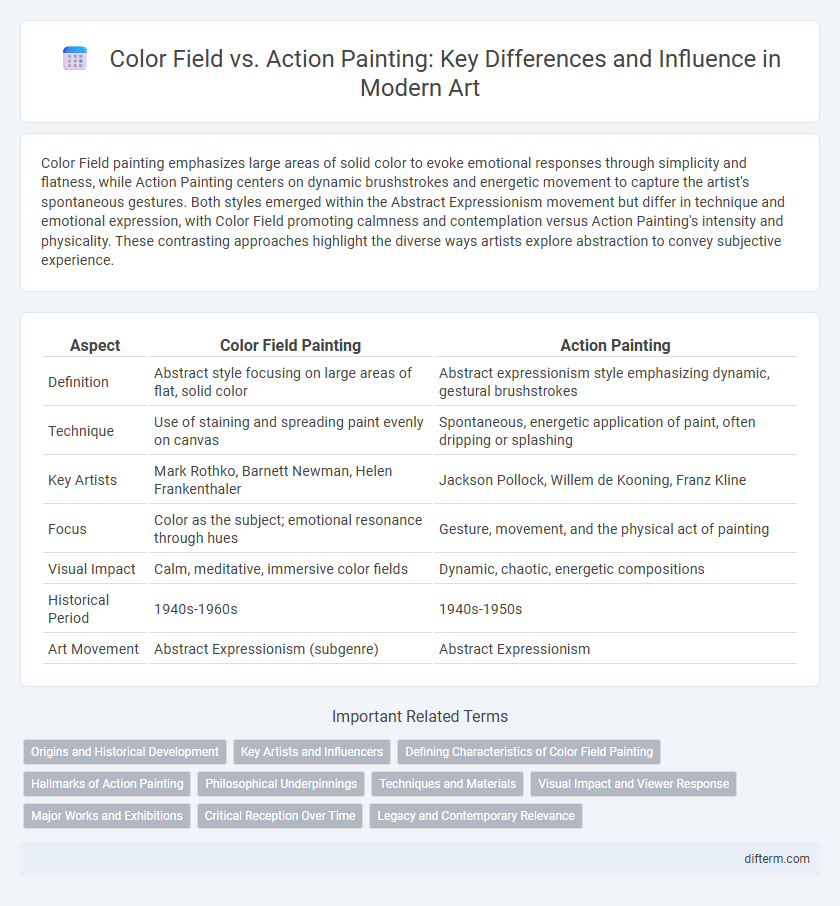Color Field painting emphasizes large areas of solid color to evoke emotional responses through simplicity and flatness, while Action Painting centers on dynamic brushstrokes and energetic movement to capture the artist's spontaneous gestures. Both styles emerged within the Abstract Expressionism movement but differ in technique and emotional expression, with Color Field promoting calmness and contemplation versus Action Painting's intensity and physicality. These contrasting approaches highlight the diverse ways artists explore abstraction to convey subjective experience.
Table of Comparison
| Aspect | Color Field Painting | Action Painting |
|---|---|---|
| Definition | Abstract style focusing on large areas of flat, solid color | Abstract expressionism style emphasizing dynamic, gestural brushstrokes |
| Technique | Use of staining and spreading paint evenly on canvas | Spontaneous, energetic application of paint, often dripping or splashing |
| Key Artists | Mark Rothko, Barnett Newman, Helen Frankenthaler | Jackson Pollock, Willem de Kooning, Franz Kline |
| Focus | Color as the subject; emotional resonance through hues | Gesture, movement, and the physical act of painting |
| Visual Impact | Calm, meditative, immersive color fields | Dynamic, chaotic, energetic compositions |
| Historical Period | 1940s-1960s | 1940s-1950s |
| Art Movement | Abstract Expressionism (subgenre) | Abstract Expressionism |
Origins and Historical Development
Color Field painting emerged in the 1940s and 1950s as an evolution of Abstract Expressionism, emphasizing large areas of solid color to evoke emotional responses through simplicity and spatial depth. Action Painting, rooted in the early 1940s New York art scene, focused on dynamic, gestural brushstrokes that conveyed the artist's physical movement and psychological intensity. Both movements originated from Abstract Expressionism but diverged through Color Field's emphasis on color and form versus Action Painting's emphasis on process and gesture.
Key Artists and Influencers
Color Field painting is defined by artists like Mark Rothko, Barnett Newman, and Helen Frankenthaler, who emphasized large areas of solid color to evoke emotional responses through simplicity and translucency. Action Painting, championed by Jackson Pollock, Willem de Kooning, and Franz Kline, focuses on dynamic, gestural brushstrokes and the physical act of painting, reflecting spontaneity and energy. Both movements significantly influenced Abstract Expressionism but represent divergent approaches: Color Field's meditative expanses versus Action Painting's vigorous motion.
Defining Characteristics of Color Field Painting
Color Field Painting is characterized by large, flat expanses of single colors or simple combinations, emphasizing pure color as the main subject rather than form or gesture. This style avoids visible brushstrokes and dramatic texture, creating a meditative, immersive experience through color saturation and tonal variation. In contrast to the dynamic intent of Action Painting, Color Field focuses on emotional resonance via color's spatial impact.
Hallmarks of Action Painting
Action painting emphasizes spontaneous, dynamic brushstrokes and physical engagement with the canvas, creating an intense, energetic rhythm that captures the artist's emotions in real-time. This style is characterized by the use of bold, gestural marks, splatters, and drips that convey movement and immediacy, contrasting with the flat, uniform color expanses of color field painting. Artists like Jackson Pollock exemplify action painting through their emphasis on the act of painting as an event, embedding the creative process within the finished work.
Philosophical Underpinnings
Color Field painting emphasizes contemplative experience and emotional resonance through large expanses of color, reflecting philosophical ideas of transcendence and unity. Action Painting foregrounds dynamic gesture and spontaneity, embodying existentialist notions of individual freedom and the subconscious mind's expression. These contrasting approaches reveal distinct philosophies: Color Field's pursuit of meditative stillness versus Action Painting's affirmation of process and physicality in art.
Techniques and Materials
Color Field painting emphasizes large, flat areas of color applied with techniques like staining and rolling, often using acrylics or oil paints on raw canvas to create a smooth, luminous surface. Action Painting relies on dynamic, gestural brushstrokes and dripping or splattering techniques, utilizing heavy-bodied oil or enamel paints to capture the artist's energetic movement and spontaneity. The contrast between these styles lies in Color Field's focus on color as the subject itself, while Action Painting prioritizes the physical act of painting as an expressive event.
Visual Impact and Viewer Response
Color Field painting emphasizes large expanses of solid color, creating a meditative visual impact that invites viewers into a calm, immersive experience. Action Painting, characterized by dynamic, energetic brushstrokes and spontaneous gestures, generates a visceral response, engaging viewers with its raw emotion and physicality. The contrasting techniques highlight how visual elements influence emotional and psychological reactions in the viewer.
Major Works and Exhibitions
Color Field painting is exemplified by Mark Rothko's "No. 61 (Rust and Blue)" and Barnett Newman's "Vir Heroicus Sublimis," with major exhibitions held at the Museum of Modern Art and the Whitney Museum. Action Painting highlights Jackson Pollock's "No. 5, 1948" and Willem de Kooning's "Excavation," prominently displayed at the Guggenheim Museum and the Tate Modern. Both movements were pivotal in the Abstract Expressionist period, emphasizing different artistic processes and visual impacts.
Critical Reception Over Time
Color Field painting initially received mixed criticism but gained appreciation for its meditative qualities and large-scale color expanses, influencing minimalism and contemporary abstraction. Action Painting was celebrated early on for its dynamic, gestural strokes that emphasized the artist's physical engagement, though some critics later viewed it as chaotic or lacking coherence. Over time, both movements have been reevaluated, with scholars recognizing their distinct contributions to post-war American art and the evolution of abstract expressionism.
Legacy and Contemporary Relevance
Color Field painting, characterized by large areas of single hues, established a legacy of meditative, immersive experiences that influenced minimalist and abstract expressionist movements. Action Painting, marked by dynamic, gestural brushstrokes, emphasized artist's physical engagement and spontaneity, shaping contemporary performance art and process-oriented practices. Both styles continue to inspire modern artists who explore emotional expression and the materiality of paint.
color field vs action painting Infographic

 difterm.com
difterm.com